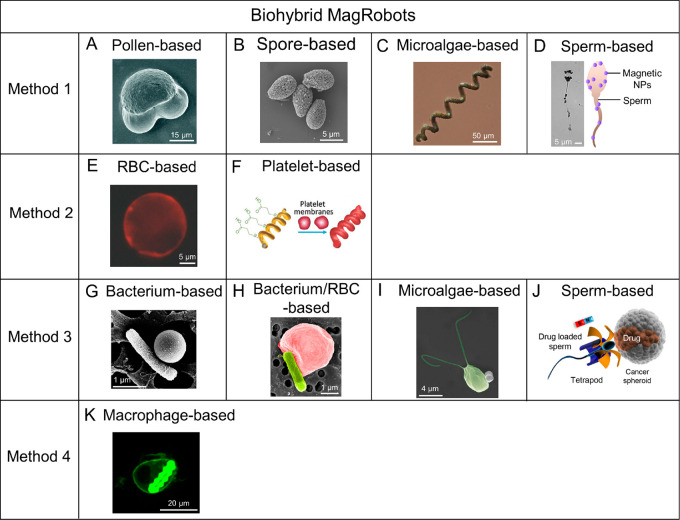Figure 13.
Representative examples of biohybrid MagRobots fabricated by four methods. Method 1: MagRobots prepared using (A) pollen, (B) spore, (C) microalgae, or (D) sperm as templates. Method 2: MagRobots prepared by cloaking functionalized nanomaterials with cell membrane of (E) red blood cells or (F) platelets. Method 3: MagRobots prepared by combining active flagella-containing cells such as (G) bacterium, (H) RGB-cloaked bacterium, (I) microalgae, or (J) sperm. Method 4: MagRobots prepared by utilizing the phagocytosis function of immune cells, for example, (K) macrophage. (A) Reproduced with permission from ref (289). Copyright 2019 The Royal Society of Chemistry. (B) Reproduced with permission from ref (296). Copyright 2019 The Authors, some rights reserved; exclusive licensee American Association for the Advancement of Science. (C) Reproduced with permission from ref (293). Copyright 2019 American Chemical Society. (D) Reproduced with permission from ref (295). Copyright 2020 The Authors, some rights reserved; exclusive licensee American Association for the Advancement of Science. (E) Reproduced with permission from ref (297). Copyright 2015 WILEY-VCH Verlag GmbH and Co. KGaA, Weinheim. (F) Reproduced with permission from ref (216). Copyright 2017 WILEY-VCH Verlag GmbH and Co. KGaA, Weinheim. (G) Reproduced with permission from ref (68). Copyright 2017 American Chemical Society. (H) Reproduced with permission from ref (306). Copyright 2018 The Authors, some rights reserved; exclusive licensee American Association for the Advancement of Science. (I) Reproduced with permission from ref (294). Copyright 2018 WILEY-VCH Verlag GmbH and Co. KGaA, Weinheim. (J) Reproduced with permission from ref (31). Copyright 2018 American Chemical Society. (K) Reproduced with permission from ref (305). Copyright 2020 The Authors, some rights reserved; exclusive licensee American Association for the Advancement of Science.

